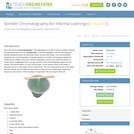
Students use chromatography to separate the components of ink.
- Subject:
- Education
- Material Type:
- Lesson Plan
- Provider:
- TeachEngineering
- Provider Set:
- TeachEngineering
- Date Added:
- 10/14/2015

Students use chromatography to separate the components of ink.
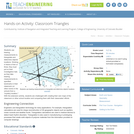
Students use bearing measurements to triangulate and determine objects' locations. Working in teams of two or three, they must put on their investigative hats as they take bearing measurements to specified landmarks in their classroom (or other rooms in the school) from a "mystery location." With the extension activity, students are challenged with creating their own maps of the classroom or other school location and comparing them with their classmates' efforts.
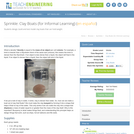
Students design, build and test model clay boats that can hold weight.
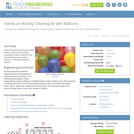
Students observe and discuss a simple balloon model of an electrostatic precipitator to better understand how this pollutant recovery method functions in cleaning industrial air pollution.

Engineers design methods of removing particulate matter from industrial sources to minimize negative effects of air pollution. In this activity, students will undertake a similar engineering challenge as they design and build a filter to remove pepper from an air stream without blocking more than 50% of the air.
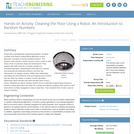
Posed with a paradigmatic engineering problem, students consider and explore mathematical algorithms and/or geometric concepts to devise possible solutions. The problem: How should a robotic vacuum move in order to best clean a floor of unknown shape and dimensions? They grapple with what could be a complex problem by brainstorming ideas, presenting the best idea for a solution and analyzing all presented solutions, and then are introduced to an elegant solution. Rather than elaborately calculating the most efficient route and keeping track of which tiles the robot has visited, a random number generator determines which direction the robot will take when it hits a barrier. Students are able to visually confirm how an unfamiliar programming concept (a random number generator) can make for a simple and efficient program that causes an NXT robot (that is suitably equipped) to clean a bare floor. Then students think of other uses for random numbers.
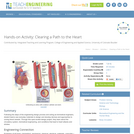
Following the steps of the engineering design process and acting as biomedical engineers, student teams use everyday materials to design and develop devices and approaches to unclog blood vessels. Through this open-ended design project, they learn about the circulatory system, biomedical engineering, and conditions that lead to heart attacks and strokes.
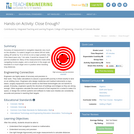
Accuracy of measurement in navigation depends very much on the situation. If a sailor's target is an island 200 km wide, sailing off center by 10 or 20 km is not a major problem. But, if the island were only 1 km wide, it would be missed if off just the smallest bit. Many of the measurements made while navigating involve angles, and a small error in the angle can translate to a much larger error in position when traveling long distances.

Students analyze international oil consumption and production data. They make several graphs to organize the data and draw conclusions about the overall use of oil in the world.
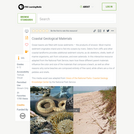
This interactive resource adapted from the National Park Service describes the different kinds of sediments that make up coastlines, with a focus on the variety in color, size, and sorting.

This interactive resource adapted from the National Park Service describes the many forces that affect shorelines, including tides, weathering, erosion, and deposition.
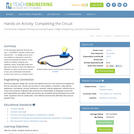
In the everyday electrical devices we use calculators, remote controls and cell phones a voltage source such as a battery is required to close the circuit and operate the device. In this hands-on activity, students use batteries, wires, small light bulbs and light bulb holders to learn the difference between an open circuit and a closed circuit, and understand that electric current only occurs in a closed circuit.
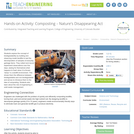
Students explore the concept of biodegradability by building and observing model landfills to test the decomposition of samples of everyday garbage items. They collect and record experiment observations over five days, seeing for themselves what happens to trash when it is thrown "away" in a landfill environment. This shows them the difference between biodegradable and non-biodegradable and serves to introduce them to the idea of composting. Students also learn about the role of engineering in solid waste management.
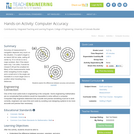
Accuracy of measurement in navigation depends very much on the situation. If a sailor's target is an island 200 km wide, sailing off center by 10 or 20 km is not a major problem. But, if the island were only 1 km wide, it would be missed if off just the smallest bit. Many of the measurements made while navigating involve angles, and a small error in the angle can translate to a much larger error in position when traveling long distances.
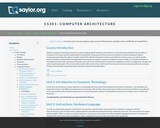
The purpose of this course is to cultivate an understanding of modern computing technology through an in-depth study of the interface between hardware and software. The student will study the history of modern computing technology before learning about modern computer architecture, then the recent switch from sequential processing to parallel processing. Upon completion of this course, students will be able to: identify important advances that have taken place in the history of modern computing and discuss some of the latest trends in computing industry; explain how programs written in high-level programming language, such as C or Java, can be translated into the language of the hardware; describe the interface between hardware and software and explain how software instructs hardware to accomplish desired functions; demonstrate an understanding of the process of carrying out sequential logic design; demonstrate an understanding of computer arithmetic hardware blocks and floating point representation; explain how a hardware programming language is executed on hardware and how hardware and software design affect performance; demonstrate an understanding of the factors that determine the performance of a program; demonstrate an understanding of the techniques that designers use to improve the performance of programs running on hardware; demonstrate an understanding of the importance of memory hierarchy in computer design and explain how memory design impacts overall hardware performance; demonstrate an understanding of storage and I/O devices, their performance measurement, and redundant array of inexpensive disks (more commonly referred to by the acronym RAID) technology; list the reasons for and the consequences of the recent switch from sequential processing to parallel processing in hardware manufacture and explain the basics of parallel programming. (Computer Science 301)
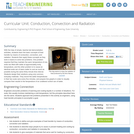
With the help of simple, teacher-led demonstration activities, students learn the basic concepts of heat transfer by means of conduction, convection, and radiation. Students then apply these concepts as they work in teams to solve two problems. One problem requires that they maintain the warm temperature of one soda can filled with water at approximately body temperature, and the other problem is to cause an identical soda can of warm water to cool as much as possible during the same thirty-minute time interval. Students design their solutions using only common, everyday materials. They record the water temperatures in their two soda cans every five minutes, and prepare line graphs in order to visually compare their results to the temperature of an unaltered control can of water.

Students make a simple conductivity tester using a battery and light bulb. They learn the difference between conductors and insulators of electrical energy as they test a variety of materials for their ability to conduct electricity.

Students are introduced to the idea of improving efficiency by examining a setting that is familiar to many teenagers fast food restaurants. More specifically, they learn about the concepts of trade-offs, constraints, increasing efficiency and systems thinking. They consider how to improve efficiency in a struggling restaurant through delegating tasks, restructuring employee responsibilities and revising a floor plan, all while working within limitations and requirements. Finally, students summarize and defend their suggested changes in argumentative essays.
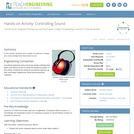
In this activity, students use a variety of materials to design and create headphones that absorb sound.
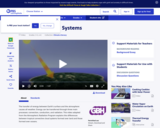
This video segment adapted from the Atmospheric Radiation Program explains the differences in the formation of tropical convective cloud systems over islands and over the ocean.